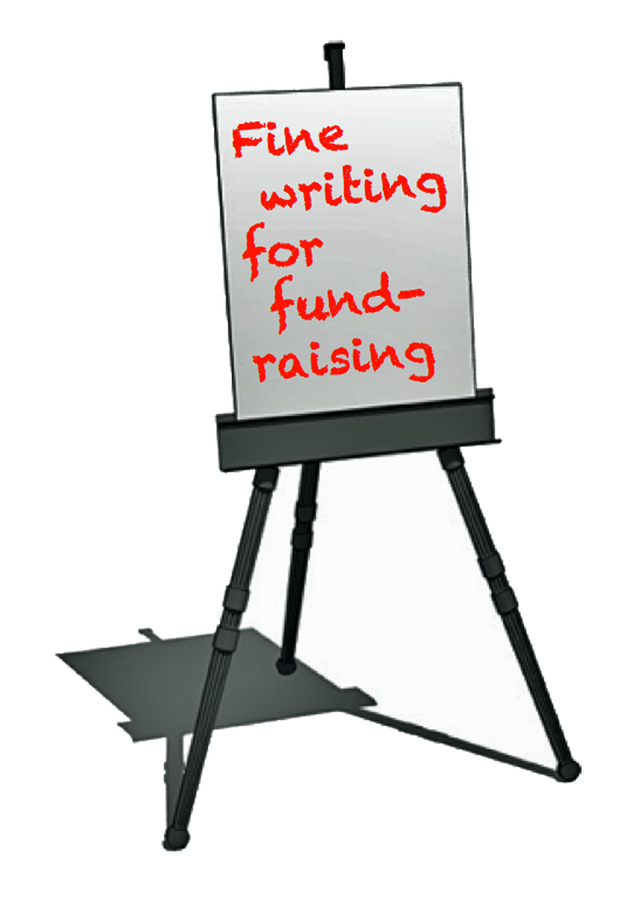Reader knowledge, real voices, great stories and big points of view
Writer Liz Loudon shares some tips about writing to raise money.
- Written by
- Elizabeth Loudon
- Added
- September 22, 2014
 A couple of years ago I scaled back my fundraising business enough to complete a novel. No, this isn’t a sale pitch (the novel’s still a work in progress), but it’s a good moment to reflect on writing as a fundraiser versus ‘creative’ writing.
A couple of years ago I scaled back my fundraising business enough to complete a novel. No, this isn’t a sale pitch (the novel’s still a work in progress), but it’s a good moment to reflect on writing as a fundraiser versus ‘creative’ writing.
As it happens, two clients asked me to write original copy for them this summer. I gladly put down my fiction-writing tools (coffee, Spotify, view of cats and pigeons) and picked up my fundraising-writing tools (ditto).
The first client is a big organisation with many programmes and a vast range of users, funders and members. They’re launching a new membership scheme alongside a new appeal copy for non-members and they wanted fresh copy. They peppered me with documents, although they couldn’t give me access to actual users. Their goal sounded simple: to raise more money.
The second client is a small charity that provides hands-on care for people in great distress. They’re much loved in their local community and now want to raise funds for a new centre. They needed a test case for an ambitious building campaign.
One of these assignments turned out to be extremely difficult, requiring multiple drafts and far more coffee-drinking, cat-watching time than I cared to admit (or felt I could bill for.) The text still hasn’t gone live either. The other was a joy. It practically wrote itself, and the client is happy

No prizes for guessing which was which, but what can we learn – whether we’re drafting thousand-page novels or end of year appeals?
Know your reader
It’s so much easier to write when you know whom you’re writing for. When I began writing a novel I wasn’t sure who my readers might be. In fact, the thought of any reader made me want to hide under the covers. Later I dared to share draft chapters with friends who are the sort of people I hope will one day buy my book. Once I could imagine real people welcoming the next chapter and caring about my characters I picked up the pace.
In fundraising, too, it’s much easier to write for a real person than for a generalised ‘anybody who might give us money’. That’s why generic copy for large organisations can leave us cold, even when we’ve used short sentences, vivid details and cameo stories from the files. I did much better when I was writing for people from a very specific local community. I knew quite a bit about their tastes, concerns and dreams and I could hold those in mind as I wrote.
Capture real voices
‘You writers always want to interview people,’ a client once told me. ‘We've done all that already – can’t you just write?’
Well, no. Nothing delights writers and readers more than snappy dialogue that reveals a person’s true character and feelings and there’s only one way to get that: by listening to real people.
For the second client, I called a few people who’ve used the charity’s services as well as some staff members and asked them to describe their experiences. I was spellbound by what they had to say. If you listen carefully you’ll inevitably hear telling details and quirky turns of phrase that you could never make up yourself. Even if you can’t use direct quotes, you may hear a lovely, warm phrase that’s just right for your charity and your reader.
Choose the strongest point of view
This is by far the hardest bit to get right, for novelists and for fundraisers. It’s closely related to knowing your reader and capturing people’s voices. It’s what gives you your voice as a writer – what makes your writing three-dimensional and truly interesting.
‘Point of view’ in writing doesn’t mean ‘opinion’ – it means the unique perspective from which we see your story. In Wolf Hall, for example, author Hilary Mantel chose to write a historical novel entirely from Thomas Cromwell’s point of view. Although she didn’t use the first person (‘I’), the reader never sees anything that Cromwell doesn’t see. The result is brilliant because Mantel fills that single-beam point of view with Cromwell’s intelligence and experience.
A close-up point of view like this will always have a powerful emotional impact, but a more omniscient point of view can pack a punch, too. Think of Tolstoy’s famous opening to Anna Karenina: ‘All happy families are alike; each unhappy family is unhappy in its own way’. Tolstoy, the grand philosopher, looks down upon his broad Russian canvas and reassures us that he’s in charge of his fictional empire: he won’t let us lose the plot.
Fundraisers often strive for this big-picture point of view, hoping to convey authority and cover broad issues quickly. It can be hard to carry off, however, especially as many fundraisers are afraid even to use the word ‘we’ for their charity. Passive verbs and jargon creep in and the omniscient point of view quickly loses focus. Our job is to persuade people to do something: donate, advocate, at least care… but when our writing fades away into jargon readers aren’t going to be persuaded to do anything, except look for something more dynamic to read.
There are no hard and fast rules in writing, but it’s usually better to choose a close-up or first-person point of view. My second client was easier to write for because I could use the word ‘we’ and could imagine myself sitting in their waiting-room telling people just why they needed that new building. For the larger client I felt a bit as if I were writing with a blindfold on. The point of view was never quite clear. Where was I, the writer, exactly? What was my feeling about the programmes? I did my best, but I wasn’t sure – so why would the reader be convinced?
Oh, and stories
I haven’t said anything here about telling stories storytelling, the much celebrated heart of great fundraising. Ken Burnett addresses stories beautifully in his new book on storytelling I would add that storytelling’s much more than plot or exotic colour. Stories come to life when they’re infused with a real wish to communicate with real readers, capture strong voices and have an energetic point of view. Without those, you’re not writing, as Truman Capote once said: you’re just typing.

















